 |
|
Antique clocks collected by Qing Long include French and British productions from the late 17th century to the 19th century.[Photo/China Daily] |
Speaking of that watch, he says: "There are many stories behind those ticking sounds."
Qing began to seriously collect antique clocks and watches around 2000, and now owns about 100 pieces.
"The number is not big compared with many collectors in China, but I prefer to have variety in my collection. Some tycoons want to collect items of the same type, but I think it is a waste of energy for me," he says.
"I once met a person who had a collection of 2,000 clocks, but most were of the same style. I would rather own only one piece of each style. Collection is a process to know more about culture, not to display wealth."
Qing's collection of British wood cabinet clocks, for example, ranges from the late 17th century to the 19th century, and covers most major historical periods of their development.
Speaking of newcomers to the hobby, he says he often finds domestic collectors have misconceptions about history of timepieces.
"People often focus too much attention on Swiss pieces, but Britain and France once dominated the industry - from the mid-17th century to the 19th century. So, I emphasize more on these two countries."
For Qing, artistic achievement and mechanical functions are equally important.
"For example, French antique clocks have some of the most extraordinary facades. The early French clocks were not able to compete with British ones in terms of complications. However, they have some of the finest designs on their cabinets."
A 1685 French clock, which has its cabinet inlaid with tortoise shell, is among his favorites.